The Language of Geometry and Mathematics
last update: 24 July 2020
On this page I'm looking at the way mathematical terms are named, and why. There are separate webpages for geometric shapes, probability and statistics, and past and present measurement systems.
Let's set the scene with a few quiz questions that touch on broad area of mathematics and geometry:-
Which came first Google or a Googol? Answer - Googol already appeared in 1937
Is the subatomic domain defined as below 10-100, or below 10-15, or below 10-6 metres? Answer - the diameter of an atomic nucleus has been estimated at ca. 10-15 metres, so anything smaller than that is considered subatomic
What is cardinality? Answer - formally it's defined as "a measure of the number of elements in a set", which means the number of distinct objects that are in defined group, and is expressed as natural number (including 0)
Now on this webpage we are focussing on mathematics-related terminology and definitions, so here mathematics-related quiz questions:-
What are integers? Answer - a number that can be written without a fraction
What are rational numbers? Answer - a number that can be written as a fraction of two integers
What are prime numbers? Answer - a prime number is a whole positive integer greater than 1 that can only be divided by itself and 1
What is a perfect number? Answer - a positive integer (natural number) that is equal to the sum of its positive divisors, excluding itself, e.g. 6 has divisors 1, 2 and 3 (excluding itself) and 1+2+3=6, so 6 is a prefect number
What is the smallest prime number? Answer - A prime number is a whole positive integer greater than 1 that can only be divided by itself and 1, so the smallest prime number is 2 followed by 3, 5, 7, …
What is the next prime number after 31? Answer - 37
What is the difference between natural numbers and whole numbers? Answer - 0 (zero) is a whole numbers but not a natural numbers
What is a decimal point? Answer - it is the decimal separator that separates the integer part from the fractional part of a number
What number is represented by the Roman numerals LXX? Answer - 70
What is the only even prime number? Answer - The only even prime number is 2 (it's also the smallest prime number)
What is an improper fraction? Answer - an improper fraction is when the absolute value is equal to or greater than 1 (e.g. 9/4 or -4/3), otherwise its a proper fraction (e.g. 4/9 or -3/4)
What is an equivalent fraction? Answer - is just another fraction that is the same as the first, so 6/12 is the same as 3/6 which is the same as 1/2
What is 1000 in Roman numerals? Answer - M
What is the smallest composite number? Answer - a composite number is just a positive integer that is formed by multiplying two smaller positive integers, but a composite number must have more factors than itself (i.e. 2) and one (1). So 1 only has one positive factor, i.e. 1, whereas 4 has two factors (4 and 2) plus 1. Let's take 17, it only has 17 and 1 as factors, so its not a composite number, but it is a prime number. In fact the definition of prime number is any number greater than 1 that has exactly two divisors, itself and 1. Excluding 0 and 1, all integers are either composite numbers or prime numbers. So 2 only has itself and 1 as divisors, and is a prime number (it is also the smallest prime number, and the only even prime number).
Fractions having the same value are known by what name? Answer - equivalent fractions
What is the number represented by the Roman numeral MMMCMXCIX? Answer - 3,999
Simple Definitions
At the simplest level modern mathematics is divided into number theory (including arithmetic), algebra, geometry, and analysis.
In addition we also have applied mathematics which includes probability and statistics, computational sciences, and physical sciences.
And we should not forget the topic of measurement, which includes measurement standards and measurement systems and units.
We have to start somewhere, so lets look at the simplest definition of some well known words:-
Basic vocabulary
Number is just a mathematical object that we use to count, measure and label things. There are a variety of different types of numbers, which we see further below.
Integer is just a whole number, or a number that can be written without a fractional component.
Integer was initially written as 'numerus sanus' and was used extensively ca. 1560-70, but the idea of a 'untouched' number certainly existed before. The first citation of a 'whole number' appeared ca. 1430. It was Thomas Digges (English, ca. 1546-1595) who used the word 'integer' when writing about numbers that were "exactly nether by integer nor fraction it can be expressed".
Constant means 'non-varying' such as a fixed and well-defined number, but it can also mean a mathematical constant or a number whose value is fixed by an unambiguous definition (such as 𝜋).
Constant was introduced by Gottfried Wilhelm Leibniz (German, 1646-1716), and was used as a noun in English as early as 1832.
Variable is something that represents an element in a set, or collection of distinct or different objects. It is often a number, but it can be a vector, a matrix or a function. In algebraic computations the variables are numbers which allows a solution to be found to a problem. There exist both independent variables and dependent variables, the first being a controllable input, and the second being an output or outcome resulting from the changes in the input.
Certainly John Radford Young (English, 1799-1885) wrote in 1831 about dependent variables and independent variables, although these terms were already in use as early as 1813. In fact the dependent variable is often called a dummy variable, a kind of placeholder that disappears in the final result. Dummy variables are also called 'bound variables' because in performing a calculation they are defined as taking up some specific value, or range of values, whereas independent variables are 'unbound' and can take any value, and are thus also called 'free variables'.
Set can look quite complicated, but it just means a well-defined collection of distinct objects, and at the same time the set itself can be considered an object in its own right. For example, 2, 4, and 6 are distinct objects, but they can form a single set of size three, written {2, 4, 6}, but which could also be written {4, 6, 2} since the order does not matter.
Set was first defined by Georg Cantor (German, 1845-1918), and it was William Frend (English, 1757-1841) who first used "set of numbers" in 1796. Obviously a set of things was a common phrase, but it was Cantor who used it in a mathematical context. In English it took some time for set to mean aggregate or ensemble, as opposed to the term 'class'.
Function is a binary relation that associates with every element in a first set, exactly one element in a second set. The usual notation is 𝑦 =𝑓(𝑥), where 𝑓 associates every element of 𝑥 (in set 𝑋) to a single element of 𝑦 (in set 𝑌). The element 𝑥 is the argument or input, and 𝑦 is the output. The argument 𝑥 is also called the independent variable, and 𝑦 is the dependent variable.
The word 'function' first appeared with Gottfried Wilhelm Leibniz (German, 1646-1716) in 1673, but he just considered it a magnitude which performed a special duty. It was Johann Bernoulli (Swiss, 1667-1748) who first used 'function' in the analytical sense, however it was Leibniz who was the first to write "function of 𝑥". The word 'function' in English appeared in 1779.
Operation is a function which takes zero or more input values (called operands) through to a well-defined output value. An operand is just an object on which some form of mathematical operation has been made. The most common operations are addition and multiplication, followed by additive inverse (a way to consider subtraction as a special case of addition) and multiplicative inverse (a way to consider division as a special case of multiplication). So the simplest form of operation could be just the addition of two numbers.
The term 'operationes' was used by Christopher Clavius (German, 1538-1612) in 1608, and appeared as operation in English in 1713.
Term is often used in mathematics but it just means a mathematical object, and they appear as components in operations. Equally a term can be something constructed from constant symbols (such 𝑥, 𝑦, 𝑧), variables (such as numbers) and binary function symbols (such as +, -, ×, ÷). In algebra we have 'like terms' which are terms that have the same variables and powers, but the coefficients don't need to match, (8𝑥𝑦𝑧2 and -5𝑥𝑦𝑧2 are like terms). In algebraic expressions a constant term has a value that is constant or cannot change because it does not contain variables.
Power (also called 'exponentiation') involves a base 𝑏 raised to the exponent or power 𝑛, written as 𝑏𝑛.
The term exponent was introduced by Michael Stifel (German, ca. 1487-1567) in 1544, and it appeared in English in 1745. Base appeared in ca. 1800 in the context of logarithms.
Coefficient is just a multiplicative factor on a term in an expression, formula or equation, so 8 is a coefficient in 8𝑥𝑦𝑧2.
The word coefficient only started to be used near the end of the 17th Century, although it is said to have first been coined by François Viète (French, 1540-1603).
Ratio indicates how many times one number contains another, and you often see a ratio expressed as 3:4 or 4:7. Ratio is identical to fraction, and very similar to proportion. A fraction is how many parts of a certain size there are, set against how many of those parts make up a unit or a whole. Proportionality is a way to say that two numerical ratios (or fractions) are equal.
In the Middle Ages ratio often meant 'computation', and they would use 'proportio' rather than ratio. Proportion appeared in 1328, and until ca. 1660 in English 'reason' was often used to mean 'ratio', until Isaac Barrow (English, 1630-1677) used ratio to mean the "respect of two magnitudes of the same kind each to the other".
Root, or more specifically the 𝑛th root, where 𝑛 is a positive integer, is usually viewed as r𝑛 = 𝑥. This means r raised to the power 𝑛 yields 𝑥, and is the same as multiplying 𝑥 by 𝑥, 𝑛 times. So 𝑛 is termed the 'degree' of the 'root'. Where the 'degree' 𝑛 is 2, the square root of a number 𝑥 is a number such that 𝑦2 = 𝑥, or in other words, a number 𝑦 whose square (𝑦 × 𝑦) is 𝑥. Where 𝑛 is 3, it's called the cube root.
The perfect root of number is just where the 𝑛th root of a number is a whole number or integer. You very often find the word root replaced by the radical symbol √, so the smallest radical is the square root √, and the next radical is the cube root ∛.
The square root in English dates from 1557 and was used by Robert Recorde (Welsh, ca. 1512-1558).
Expression is a finite combination of symbols, so numbers (constants), variables, operations, functions, brackets, punctuation, all organised according to a logical syntax. Experts think of an expression as a mathematical object, a formula as a statement about mathematical objects, and an equation as a statement on the equality of two expressions.
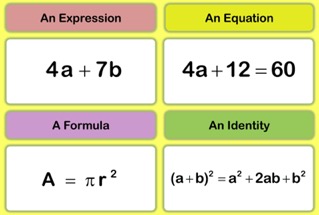
The fourth example above, is the identity which is an equality between two mathematical expressions.
The word equation, 'equatio' in Latin, appears to be a translation from an Arabic term, and was widely used by Medieval writers. Equation appeared in English in 1570 in a translation of Euclid's Elements by with Henry Billingsley (English, died 1606).
The word 'formula' first appeared in the phrase "an algebraic formula" from Richard Kirwan (Irish, 1733-1812) in 1796.
The identity as a type of equation was mentioned in 1831 by John Radford Young (English, 1799-1885).
A numeral system is the mathematical notation we use to express numbers, variables, operators such as '+', and including the use of the decimal (base-ten) including the decimal notation with the decimal separator.
The word 'decimal' derives for the Latin 'decimus', meaning tenth. Even in the earliest books (ca. 1492) there was the mention of 'decimal numbers', and the word 'decimal' appeared in English in 1608 from a translation of a book by Simon Stevin (Flemish, ca. 1548-1620).
Peter Barlow (English, 1776-1862) mentioned the 'decimal system' in his book 'An Elementary Investigation of the Theory of Numbers' (1811). He also used in the same book the word 'base' for a number system.
The decimal separator could have been either a period or comma and was used in 1617 by John Napier (Scottish, 1550-1617) to separate the whole part from the fractional part. The decimal separator was once also called the 'separatrix', but reference to a 'decimal point' certainly dates back to 1771.
According to some experts the Romans seem to have divided numbers below 100 into 'digiti' (fingers), 'articuli' (joints), and 'compositi' (composites of fingers and joints). Robert Recorde (Welsh, ca. 1512-1558) wrote in 1558 "A diget is any numbre under 10".
Reference to the 'metric system' first appeared in 1806 with a reference to a "new French weights and measures".
Numbers
Number is a mathematical object used to count, measure and label something.
The term 'countable' was introduced by Georg Cantor (German, 1845-1918) in a paper from 1883.
Numbers can be natural numbers, i.e. used for counting and ordering, so 1, 2, 3, … 342, …
Cardinal numeral is just the name give to the number of objects that are counted, like one, two, three .. or three hundred and forty-two. Cardinal numbers are a generalisation of the natural numbers used to measure cardinality (or the number of distinct objects) of sets (which are well defined collections of distinct objects). In mathematical terms a set A = {2,4,6} contains 3 elements, therefore the cardinality of A is 3.
Ordinal numeral is a name given to represent a position or rank in a sequential order (so first, second, third, …). A sequence is just an enumerated collection of objects in which repetitions can happen but where order does matter. So we might have 1st, 2nd, 3rd, …, 11th, …. 277th, …, as an example 11 November actually means the 11th day in November.
The idea of a succession of natural numbers in order (a sequence) was first mentioned in 1882.
The use of 'cardinal' as being the "principall, upon which the rest depend, …" was mentioned by Richard Percivale (English, 1550-1620) in his Bibliotheca Hispanica of 1591.
In its simplest form whole numbers include all natural numbers and 0 (zero), i.e. 0, 1, 2, 3, …, 342, … These whole numbers are also called integers, whereas 9.75, 5⅓, √2 are not integers. Integers are just numbers that can be written without a fractional component. Numbers that start with 0, 1, 2, 3, … are called positive integers, whereas -1, -2, -3, …, -342, … are called negative integers. The words 'whole numbers' is not precisely defined, and you can find the expression 'whole numbers' being used both for natural numbers 0, 1, 2, 3, … (with the 0), and for all numbers -342, …-3, -2, -1, 0, 1, 2, 3, …, 342, …
In principle, all natural numbers are whole numbers, but all whole numbers are not natural numbers. The difference is the presence of 0 (zero) in whole numbers. Why is 0 (zero) not a natural numbers? One answer is that natural numbers are alway positive integers and by definition 0 (zero) is neither positive nor negative. Historically most numbering systems did not have a 0 (zero), e.g. there was not a Roman numeral for 0 (zero) because there was not a use for counting 0 (zero) items. If you really want to examine this in detail, check out "Is Zero a Natural Number?".
Alongside integers there are several types of non-integers, i.e. fractions such as -⅔ or 4⅓, and decimal numbers such a -3.67 and 27.1593.
Rational numbers are numbers that can be expressed as a fraction (p/q) of two integers, and given that q may be 1, every integer is a rational number. The important thing is that a rational number always ends after either a finite number of digits, or they begin to repeat the same finite sequence of digits over and over again. So rational numbers include all integers, fractions (p/q) of two integers, perfect 𝑛th roots of numbers, and decimal numbers that terminate such as 5.942 or those that do not terminate but settle into a permanently repeating pattern such as 4.333333…
The repeating (or circulating) decimal was first found in 1768 by John Roberson (English, 1712-1776). The 'infinite decimal', those that never terminate but do not repeat, was first found in 1796 by Charles Hutton (English, 1737-1823).
An irrational number is by definition not a rational number and that means that a ratio or fraction (p/q) goes on without ending or repeating a sequence of digits. For example, Pi is an irrational number because it cannot be expressed as a common fraction (a fraction (p/q) of two integers), although 22/7 is commonly used as an approximation. The decimal representation of Pi never ends and never settles into a permanently repeating pattern.
It has been said that the Greeks used 'arrhetos' (unspeakable) for irrational numbers, and 'rhetos' (rational) for rational numbers. It was Cassiodorus (Roman, ca. 485-585) who is thought to have used the words in their 'modern' sense. Robert Recorde (Welsh, ca. 1512-1558) first used irrational in English in 1551, and John Wallis (English, 1660-1703) first used rational is 1685.
A good working definition of a rational number is the quotient of two integers, as long as the denominator is not zero.
Real numbers start with 0 and progresses 0, 1, 2, 3, …, and these are also called non-negative integers (or positive integers).
A real number is a value of a continuous quality that can represent a distance along a line. A quality can be a multitude (counting the number in a set of objects) or magnitude (the size of a mathematical object). We will see later that a line is just an idealised object that has just one dimension, length. Real numbers include all rational numbers but also includes 0.
It was René Descartes (French, 1596-1650) who introduced the concept of real numbers.
Continuous has been around for at least 250 years but the meaning "smooth and without discontinuity" appears to date from ca. 1812. Most of the references are to continuous functions, continuous curves, and continuous curved surfaces.
0 (zero) appears to have derived from a Sanskrit word meaning 'void'. The Arabic word became zephirum in Latin and was used by Fibonacci (Italian, ca. 1170-1240). By 1515 zéro was used in the French language, and in 1604 zero appeared in English. Although it is said that cipher meant the same things, was used earlier in English, and remained in use until the late 19th Century.
A useful summary can be found in this Venn diagram, a form of presentation first introduced in 1866 by John Venn (English, 1834-1923).
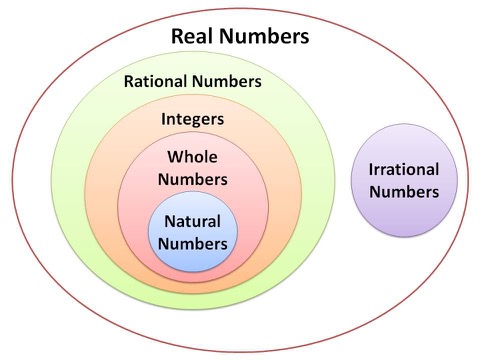
Natural numbers are 1, 2, 3, … (all positive numbers used for counting things)
Whole numbers are 0, 1, 2, 3, …, 72, …, 431, … (0, and all positive counting numbers)
Integers are ..., -562, … -3, -2, -1, 0, 1, 2, …, 93, … (all whole positive and negative numbers, and 0)
Rational numbers are 14, -⅔, 0.161, -1.403, 2.7, √25, ∛27, … (any number that can be written as a fraction, including repeating or terminating decimals, perfect roots, …)
Irrational numbers are 𝝅, √2, √3, … √(8/23), … (non-repeating or non-terminating decimals, and non-perfect roots, …)
Real numbers include all rational and irrational numbers
Complex numbers are composed of real numbers and an imaginary number (which is a real number multiplied by the imaginary unit 𝓲).
We will not be looking at complex numbers on this webpage, but it's worth noting that it was Carl Friedrich Gauss (German, 1777-1855) who in 1831 gave to (a + b𝓲) the name "numeros integros complexos" and called 𝓲 the "quantitatem imaginarium" √-1. The term complex numbers was used in English in 1856 by William Rowan Hamilton (Irish, 1805-1865).
However it was René Descartes (French, 1596-1650) who first introduced the terms 'imaginary' and 'real' in 1637, and the terms later appeared in English in 1668.
What is the difference between a real number, an irrational number, an imaginary number and a complex number?
There are a variety of 'numbers' that have special meanings or definitions, and here are just a few:-
Parity means that every integer is either an odd or even number. This was already known by Pythagoras (Greek, ca. 570-495 BC), Philolaus (Greek, ca. 470-385 BC), and Euclid (Greek, ca. 300 BC). Pythagoreans used 'gnomon' for negative numbers, and the word was still in use in England in 1701.
By the 14th Century positive numbers were 'numeri veri', or abundantes', or 'affirmative'. It is said that Brahmagupta (Indian, ca. 598-668) introduced negative numbers. Later they were referred to as 'numeri ficti', 'numeri absurdi', 'absurde nomber', 'defectivi', and the word 'negative' was first used by Johann Scheubel (German, 1494-1570) in 1551, and in English it appeared in 1673.
Prime numbers - are natural numbers (positive integers) greater than 1, and not a product of two smaller positive integers. A prime number is a whole positive integer greater than 1 that can only be divided by itself and 1, so the smallest prime number is 2 followed by 3, 5, 7, …
Prime numbers were mentioned by Henry Billingsley (English, died 1606) in his translation of Euclid's Elements (1570).
Composite numbers are positive integers that can be produced by multiplying two smaller positive integers.
John Napier (Scottish, 1550-1617) used the term "numeri compositi", and in 1723 there was a reference to 'incomposite numbers' as being the same as prime numbers.
So excluding the unit 1, every positive integer is either a prime number or a composite number.
Figurate numbers are a generalisation from triangular numbers to different shapes. Triangular numbers count objects that are arranged in an equilateral triangle, as shown below.

There are also (perfect) square numbers, square triangle numbers, pentagonal numbers, hexagonal numbers, … and more generally polygonal numbers.
It is said that Pythagoras (Greek, ca. 570-495 BC) was acquainted with triangular numbers, and studied a whole range of figurate numbers. According to the experts figurate numbers are interesting for the specialist because they can be studied both algebraically and geometrically.
Perfect numbers are positive integers that are equal to the sum of its positive divisors, excluding the number itself, e.g. 6 has the divisors 1, 2 and 3, which add to 6, thus 6 is a perfect number. The surprising thing is that there are not many perfect numbers, because 6 is one you just think that there must be a lot of them. However the next one after 6 is 28, then 496, and then 8128, …
Pythagoras (Greek, ca. 570-495 BC) knew about perfect numbers but may not have used the same definition. They were mentioned by Henry Billingsley (English, died 1606) in his translation of Euclid's Elements (1570).
Transcendental numbers are complex numbers, and are not algebraic numbers. The most obvious transcendental number is 𝜋.
Constructible numbers
Roman numerals

The current year (2020) is written MMXX, and the largest number that can be represented in the standard notation is 3,9999 or MMMCMXCIX.
Arithmetic
Arithmetic involves the properties of numbers and the operations we can apply to them.
The modern English word derives from 'arithmetike', which derives from the Latin 'arithmetica', which comes from the Greek word for number 'arithmos'. The Greeks separated the theory of numbers from the art of calculating 'logistike'.
Addition - involves finding the sum of a series of numbers. The numbers to be added together are called addends (or summands), so you have one addend plus another addend equalling a sum or total.
Fibonacci (Italian, ca. 1170-1240) used the Latin 'additio' as well as 'compositio' and 'collectio' to mean addition, and 'addicion' was used in English as early as ca. 1300.
Johann Scheubel (1494-1570) published in 1545 'number addendi' to mean numbers to be added, and addend was certainly used in English by Samuel Jeake (1623-1690) in 1674.
The equals sign '=' indicating equality was invented in 1557 by Robert Recorde (Welsh, ca. 1512-1558), who also introduced the pre-existing '+' to English speakers in the same year.
Subtraction - involves the operation of removing objects from a collection. Taking one number from another starts with a minuend (first number) from which a subtrahend (second number) is subtracted leaving a difference (the result).
minuend - subtrahend = difference
The concept of additive inverse (a way to consider subtraction as a special case of addition) may only date from 1941.
Fibonacci (Italian, ca. 1170-1240) used 'I take' rather than 'I subtract', and in 1542 Robert Recorde (Welsh, ca. 1512-1558) wrote "Than do I rebate 6 out of 8, and there resteth 2". In 1572 Thomas Digges (English, ca. 1546-1595) wrote "to subduce or substray any sume, is wittily to pull a lesse fro a bigger number", and it was again Robert Recorde who actually used 'subtract' in 1557.
The plus and minus signs '+' and '-' appeared in the 14th C or 15th C to mean 'betokeneth more' and 'betokeneth lesse'. The '+' maybe a simplification of 'et', and the '-' may come from the tilde ∼ over a number which indicated subtraction. It was Henricus Grammateus (German, ca. 1495-1526) who first used the signs in the modern sense in 1518, and it was certainly routinely used by ca. 1700.
Multiplication - is often presented as a repeated addition, where the multiplicand (second number) tells us the number of times the multiplier (first number) needs to be summed together. The multiplier (first number) multiplied by a multiplicand (second number) results in a product (the multiplier and multiplicand can also be called factors).
multiplier × multiplicand = product
It is said that the first use of the word multiplication was by John Gower (English, ca. 1330-1408) in 1390. The multiplication sign '×' is traditionally attributed to William Oughtred (English, 1575-1660), but may have been in use earlier. It is suggested that Albertus Magnus (German, ca. 1200-1280) and Fibonacci (Italian, ca. 1170-1240) used product as the result of multiplication.
Division - in its simplest form it tells us the number of time one number (divisor) is contained with another number (dividend). The dividend (first number) divided by a divisor (second number) and the result is expressed as a quotient and a remainder (a 'left-over')
dividend ÷ divisor = quotient and remainder
The words 'dyuision' and 'dyvyser' already existed, ca. 1300. The division sign '÷' was first used in 1659 by Johann Rahn (Swiss, 1622-1676). Medieval writers would use 'numerus residuus' or 'residua', and it was Robert Recorde (Welsh, ca. 1512-1558) who first used 'remainer'.
Fraction - is expressed as a numerator (first number) divide by a denominator (second number)
numerator/denominator = fraction
The words numerator ('denominans') and denominator ('denominatus') were already found in 1202 in a book by Fibonacci (Italian, ca. 1170-1240).
The word fraction must derive from the Latin 'frangere' (to break), and some writers called fractions "broken numbers". 'Fractio' was in use in ca. 1200, and 'fraccions' in ca. 1390. Thomas Digges (English, ca. 1546-1595) wrote of "the vulgare or common Fractions" in 1572.
Originally there was a horizontal fraction bar, but the '/' was introduced in 1718 by Thomas Twining (English, 1675-1741), who is said to have listed tea weights as ¼ pounds, etc.
The use of "the vulgare or common Fractions" was to distinguish an ordinary fraction from a sexagesimal fraction.
The fraction (p/q) of two integers is called a common fraction.
An improper fraction is when the absolute value is equal to or greater than 1 (e.g. 9/4 or -4/3), otherwise its a proper fraction. The proper fraction appeared in 1674 with Samual Jeake, the younger (English, 1652-1699).
A quotient is a quantity produced by the division of two numbers, and is commonly referred to as a fraction or ratio. As an example, let's divide 20 (the dividend) by 3 (the divisor), so '20/3' obtains the quotient 6⅔. The dividend is also called the numerator, and the divisor is also called the denominator.
A fraction, represents a part of a whole. So the numerator (20 in our example) represents a number of equal parts making up a whole, and the denominator (3) indicates how many of those parts make up a unit. So we can see that in the whole there are 6 units and an additional ⅔ of a unit. Denominators can never be zero, because zero parts can never make up a whole (division by zero is undefined).
A ratio indicates how many times one number contains another (e.g. 16/9 (or 16:9) is a common expression for the aspect ratio of a television of computer screen and means a width of 16 units and a height of 9 units).
Algebra
Wikipedia defines algebra as the study of mathematical symbols ('+' and '-', …) and the rules for manipulating these symbols. The more basic parts of algebra are called elementary algebra, which is what we will focus on here.
The word algebra comes from the Arabic 'al-jabr' (ca. 825 AD), and means "the reunion of broken parts". It refers to the operation of transposing a subtracted quantity on one side of an equation to the other side as an added quantity. However, when the Moors entered the Iberian Peninsula in the Middle Ages, 'algebrista' was someone who set broken bones. Even in England in 1541 an 'algebrista' set bones and treated dislocations. In the mathematical sense, 'al-jabr' was either termed 'analytic art' or 'algiebar', but by 1600 the word algebra had come to mean the study of solving equations. Starting in the 19th Century the domain of algebra was expanded considerable to include groups, fields, matrices, vectors, etc. (topics beyond the scope of this webpage).
Expressions associated with algebra appeared at different times, e.g. algebraic quantity dates from 1673, algebraic function dates from 1794, and algebraic geometry dates from 1821.
Mathematical symbols can designate numbers (constants often expressed as a, b, c), variables (unknowns expressed as 𝑥, 𝑦, 𝑧), operations (+, -, , ), functions, brackets, punctuation, and grouping to help determine order of operations, and other aspects of logical syntax.
Mathematical notation is a kind of writing system for mathematics. Below we have the example used in Wikipedia for a mathematical expression, or more specifically an algebraic expression.

As we have already mentioned earlier, experts think of an expression as a mathematical object, and a formula is a statement about mathematical objects, so 8𝑥 - 5 is an expression, and 8𝑥 - 5 ≥ 5𝑥 - 8 is a formula (and is valid for all positive numbers of 𝑥).
But what is the difference between a mathematical expression and an algebraic expression? Firstly, algebraic expressions are a subset of mathematical expressions.
An algebraic expression is built up from integer constants, variables, and the algebraic operations (addition, subtraction, multiplication, division and exponentiation by an exponent that is a rational number, and thus also includes the 𝑛th root). Transcendental numbers such as 𝜋 are complex numbers, and are not algebraic numbers and cannot figure in algebraic expressions.
Algebraic expressions include algebraic numbers and can result in algebraic solutions.
Algebraic numbers first appeared in 1870 with Hermann Schwarz (German, 1843-1921), although 'algebraic quantity' was already mentioned in 1673.
The Wikipedia article on algebraic numbers gives an extensive definition of what is and is not an algebraic number. Here we will just note a few of those definitions:-
All rational numbers are algebraic numbers (so any number that can be expressed as a fraction p/q of two integers is an algebraic number)
Algebraic numbers are constructible number, which is any real number 'r' (represented as a distance along a line), if and only if, given a line segment of unit length, the line segment of length |r| can be constructed with compass and straightedge in a finite number of steps. We will meet again line segments, etc. when we look at the general concepts of geometry.
Another way to consider a constructible number is that it is any number that can be represented by a finite number of additions, subtractions, multiplications, divisions and a finite number of square root extractions of integers. In addition any expression that is formed from algebraic numbers using any combination of those basic arithmetic operators mentioned above will give another algebraic number.
Note: |r| is this context means absolute value or modulus, or the non-negative value of r (e.g the absolute value of a and of -a is always a).
https://fsw01.bcc.cuny.edu/mathdepartment/Courses/Math/MTH01/allmath01.pdf
https://www.researchgate.net/publication/226971155_The_Arithmetic-Algebra_Connection_A_Historical-Pedagogical_Perspective
histity of artimatic pdf
Binary functions
Linear
Exponential
Simple Geometry
First the word geometry
https://en.wikipedia.org/wiki/Straightedge_and_compass_construction
Presenting Data
One of the simplest ways to display two variables from a set of data is is to use a scatter plot.
Statistical Terms and Meanings
https://en.wikipedia.org/wiki/Glossary_of_probability_and_statistics
Measurement Units
http://www.economics.soton.ac.uk/staff/aldrich/Mathematical%20Words.htm
https://www2.latech.edu/~bmagee/latin/latin_links.htm
Number Paradoxes
Types of Angle
Right angle - An angle whose measure is 90° is called a right angle.
Acute angle - An angle whose measure is less than 90° is called an acute angle.
Obtuse angle - An angle whose measure is more than 90° but less than 180°, is called an obtues angle.
Straight angle - An angle whose measure is 180° is called a Straight angle.
Reflex angle - An angle whose measure is more than 180° but less than 360°, is called a Reflex angle.
Complete angle - An angle whose measure is 360°, is called a complete angle.
Equal angle - Two angles are said to be equal , if they have the same measure.
Complementary angleTwo angles are said to be complementary if the sum of their measures is 90. For example, angles measuring 65° and 25° are complementary angle.
Supplementary angle - Two angle are said to be supplementary if the sum of their measures is 180°. For example, angles measures 70° and 110° are supplementary.
Adjacent angle - Two angles are called adjacent angle if they have the same vertex and a common arm such that non-common arms are on either side of the comman arm. In the given figure , ∠AOC and ∠BOC are adjacent angle.
Types of Triangle
- A triangle having all sides equal is called an equilateral triangle.
- A triangle having two sides equal, is called an isosceles triangle.
- A triangle having all sides of different lengths,is called a scalene triangle.
- A triangle one of whose angles measures 90°,is called a right triangle.
- A triangle one of whose angle lies between 90° and 180° is called an obtuse triangle.
- A triangle each of whose angle is acute, is called an acute triangle.
- The sum of all sides of a triangle is called the perimeter of the triangle.
- The sum of two sides of a triangle is greater than the third side.
- In a right angled ABC in which ∠B = 90°, we have AC2 =AB2+BC2. This is called Pythagoras Theorem.
Quadrilateral
A figure bounded by four straight line is called a quadrilateral. The sum of all angles of a quadrilateral is 360°.
Rectangle - A quadrilateral is called a rectangle, if its opposite side are equal and each of its angle is 90°. In given fig. ABCD is a rectangle.
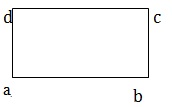
Square - A quadrilateral is called a square, if all of its sides are equal and each of its angles measures 90°. In given fig. ABCD is square in which AB = BC = CD = DA.
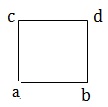
Parallelogram - A quadrilateral is called a parallelogram, if its opposite sides are parallel. In given fig. ABCD is a parallelogram in which AB = DC & AD = BC.
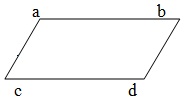
Rhombus - A parallelogram having all sides equal is called a rhombus. In given fig. ABCD is a rhombus in which AB =BC =CD=DA, AB || DC and AD || BC.
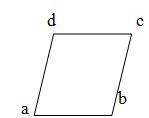
- A quadrilateral is a rectangle if opposite sides are equal and its diagonals are equal.
- A quadrilateral is a Square if all sides are equal and the diagonal are equal.
- A quadrilateral is a parallelogram, if opposite sides are equal.
- A quadrilateral is a parallelogram but not a rectangle, if opposite sides are equal but the diagonals are not equal.
- A quadrilateral is a rhombus but not a square if all their sides are equal and the diagonals are not equal.
- In a parallelogram, we have
- Opposite sides are equal.
- Opposite angles are equal.
- Each diagonal bisects the parallelogram.
- Diagonals of a parallelogram bisect each other.
- Diagonals of a rectangle are equal.
- Diagonals of a rhombus bisect each other at right angles.
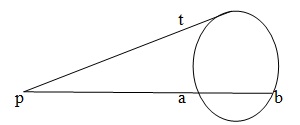
- The perpendicular from the center to a chord bisects the chord.
- There is one and only one circle passing through three non collinear points.
- Angle in a semi circle is a right angle.
- Opposite angles of a cyclic quadrilateral are supplementary.
- Angle in the same segment of a circle is equal.
- The tangent at any point of a circle is perpendicular to the radius through the point of contact.
- Two tangent to a circle from a point outside it are equal.
- If PT is a tangent to a circle and PAB is a secant, Then PA x PB= PT2
https://www.tutorialspoint.com/quantitative_aptitude/aptitude_geometry.htm
There's an anecdote about how the philosopher-mathematician Pythagoras overcame a student's natural dislike of geometry. The student was poor, so Pythagoras offered to pay him an obol for each theorem he learned. Eager for the money, the student agreed and applied himself. Soon, however, he became so intrigued, he begged Pythagoras to go faster, and even offered to pay his teacher. In the end, Pythagoras recouped his losses.
Etymology provides a safety net of demystification. When all the words you hear are new and confusing, or when those around you put old words to strange purposes, a grounding in etymology may help. Take the word line. You put your ruler to paper and draw a line against the straight edge. If you're an actor, you learn your lines -- line after line of text in a script. Clear. Obvious. Simple. But then you hit Geometry. Suddenly your common sense is challenged by technical definitions*, and "line," which comes from the Latin word linea (a linen thread), loses all practical meaning, becoming, instead, an intangible, dimension-less concept that goes off at both ends to eternity. You hear about parallel lines that by definition never meet each other -- except they do in some warped reality dreamt up by Albert Einstein. The concept you have always known as the line has been renamed "line segment."
After a few days, it comes as something of a relief to run into an intuitively obvious circle, whose definition as a set of points equidistant from a central point still fits your previous experience. That circle** (coming possibly from a Greek verb meaning to hoop around or from a diminutive of the circular Roman circus, circulus) is marked with what you would have, in pre-geometry days, called a line across part of it. This "line" is called a chord. The word chord comes from the Greek word (chordê) for a piece of animal gut used as a string in a lyre. They still use (not necessarily cat) gut for violin strings.
After circles, you'll probably study equiangular or equilateral triangles. Knowing the etymology, you can break those words up into component parts: equi (equal), angular, angle, lateral (of a side/sided), and tri (3). A three-sided object with all sides equal. It is possible that you'll see triangle referred to as trigon. Again, tri means 3, and gon derives from the Greek word for corner or angle, gônia. However, you're far more likely to see the word trigonometry -- trigon + the Greek word for measure. Geo-metry is the measure of Gaia (Geo), the Earth.
| If you're studying geometry, you probably already know you must memorize theorems, axioms, and definitions corresponding with names. |
| cylinder |
| dodecagon |
| heptagon |
| hexagon |
| octagon |
| parallelogram |
| polygon |
| prism |
| pyramid |
| quadrilateral |
| rectangle |
| sphere |
| square and |
| trapezoid. |

The Greek series proto-, deutero-, trito-, ... is only found in prefixes, generally scholarly and technical coinages, e.g. protagonist, deuteragonist, tritagonist; protium, deuterium, tritium; Proto-Isaiah, Deutero-Isaiah.[3] Numbers beyond three are rare; those beyond four are obscure.
The first twelve variations of ordinal numbers are given here.
| Spatial or chronological | Precedence or effect | Greek prefix |
| first | primary | proto- |
| second | secondary | deutero- |
| third | tertiary | trito- |
| fourth | quaternary, | quartarytetarto- |
| fifth | quinary | (pempto-) |
| sixth | senary | (ecto-, hecto-) |
| seventh | septenary | (ebdomo-, hebdomo-) |
| eighth | octonary | (ogdo-) |
| ninth | nonary | (enato-) |
| tenth | decenary | [4](decato-) |
| eleventh | undenary | (endecato-) |
| twelfth | duodenary | (dodecato-) |
References
Jeff Miller has a fantastic set of webpages dedicated to "Earliest Known Uses of Some of the Words of Mathematics" and "Earliest Uses of Various Mathematical Symbols"